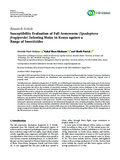Susceptibility Evaluation of Fall Armyworm (Spodoptera frugiperda) Infesting Maize in Kenya against a Range of Insecticides

View/
Date
2022-08-08Author
Gichere, Savinda Njeri
Khakame, Kakai Shem
Okoth, Patrick
Metadata
Show full item recordAbstract
The fall armyworm, Spodoptera frugiperda (J. E. Smith), is a worldwide pest of gramineous crops and a major pest of corn. Kenya has, in the recent years, reported massive outbreaks of this pest causing huge economic losses in maize fields. The indiscriminate use of insecticides has led to the evolution of insecticide resistance. This presents serious challenges to the control of pests including fall armyworm. The fall armyworm infestation has greatly threatened food security in Kenya. Consequently, this has heightened the need to evaluate the susceptibility of the fall armyworm to commonly used insecticides in Kenya. In this study, thirteen populations of the fall armyworm were sampled from thirteen counties of Kenya and determined its susceptibility to a range of insecticides using leaf-dip bioassay method. The current study illustrated the high toxicity of spinetoram, spinosad, lufenuron, and pyridaben to fall armyworm while indoxacarb, deltamethrin, lambda-cyhalothrin, imidacloprid, and abamectin exhibited relatively low toxicity to fall armyworm. Possible cross-resistance between abamectin, imidacloprid, deltamethrin, indoxacarb, spinosad, spinetoram, and lufenuron was determined through pair-wise correlational analyses. Results of this study revealed no cross-resistance between lambda-cyhalothrin with all other insecticides tested. Susceptibility monitoring of the fall armyworm can be a valuable strategy in the control of fall armyworm in the field populations. This can help inform the policy to design management strategies that promote the judicious use of these chemicals and prolong their efficacy in the management of the fall armyworm in Kenya.
URI
https://doi.org/10.1155/2022/8007998http://ir-library.mmust.ac.ke:8080/xmlui/handle/123456789/2093
Collections
- Gold Collection [1026]
